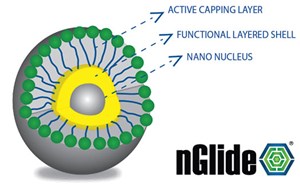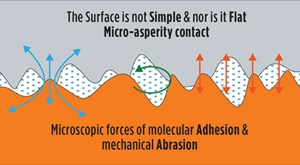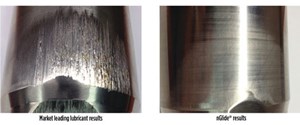What’s new in production: Nano Fluids - Lubricants
In my December 2021 column, while discussing heat exchangers, I introduced you to the concept of Nano Fluids. Nano Fluidics is an area of the broader “NanoTechnology” that uses nano-sized particles to “functionalize” a fluid (rather than a surface) to better perform a specific function. In the heat exchanger column, I discussed the use of certain nano-particles to increase the thermal conductivity of fluids used in heat exchangers.
This month, I’d like to expound a bit more on a particular type of nano-fluids: Nano-Lubricants.
VinTech Nano Materials manufactures a unique family of proprietary hybrid nanoparticles called nGlide. As shown in Fig. 1, an nGlide particle has a nanoparticle core surrounded by one or more functional materials. The final size of the nGlide particle is still in the nanometer range. This means that they will not settle out in a fluid. When added to lubricants, the nGlide particles coat the lubricated surfaces at the nanometer level. As shown in Fig. 2, even highly polished surfaces, such as bearings, have microscopic imperfections (or roughness) that result in a constant compression-relaxation cycle that not only increases friction, but also generates heat. When added to a lubricant, the nGlide particles constantly fill the “roughness gaps” to prevent this compression-relaxation cycle. The result is a significant reduction in friction and heat, and significantly longer lives for the lubricated parts.
VinTech Nano Materials actually doesn’t sell nGlide particles. Instead, they offer a series of 21 individual lubricants under the AtomLube™ label, and a series of 17 individual oils under the AtomOil™ label. Each of these products, including the nGlide particles, are designed to perform a specific function under a particular set of operating conditions.
Some examples. AtomOil Engine Oil Treatment for lubrication of rotating equipment; AtomOil Extreme Pressure Gear Oil for gear boxes; AtomOil Drone Oil for lubrication of delicate instrumentation; AtomOil Ultra Wireline Lubricant 12750 for protection of slickline, braided line, coiled tubing, snubbing pipe, and perhaps wire rope against salt water and H2S corrosion.
In addition, there is the AtomLube series of six greases, sealants, lubricants and anti-seize pastes for valves; AtomLube series of 13 greases and lubricants for a variety of lubrication applications; and two AtomLube dielectric greases.
So, what’s the prize? AtomOil Engine Oil Treatment has shown a 43% reduction in an engine’s steady state friction and a significant increase in oil film activation. AtomLube Frac Stack Grease has shown a 20% reduction of friction, a 90% reduction in wear, and a 50% increase in load capacity of frac stack valves. AtomLube Anti-Seize Lubricant has shown a 90% reduction in wear and a 60% increase in load capacity on the valve stem of frac stack valves. AtomLube Ultrared Trucking Grease has shown a 40% reduction in friction and a 20% reduction in wear on frac and transportation truck kingpins.
Figure 3 demonstrates the positive effects of AtomLube® on the bonnet sleeve cam of a frac valve after a 10,000-cycle wear test. With the AtomLube®, there was no detectable friction or wear. This resulted in a reduction in valve downtime and repair costs. For more information go to: www.vintechnm.com.
- ESP challenges in an EOR project after breakthrough: An analysis of continuous improvement for ESP designs towards the reduction of OPEX (June 2024)
- Explaining sand erosion in oil and gas production (June 2024)
- Rethinking sand management for optimized production (June 2024)
- Leveraging artificial lift to optimize production (June 2024)
- New technology allays permanent magnet motor safety concerns, enables better ESP performance (June 2024)
- Embracing automation: Oil and gas operators leverage new operational efficiencies (May 2024)





